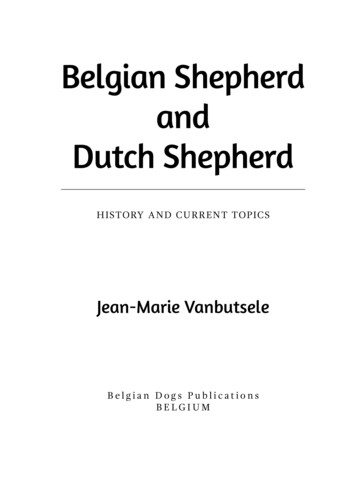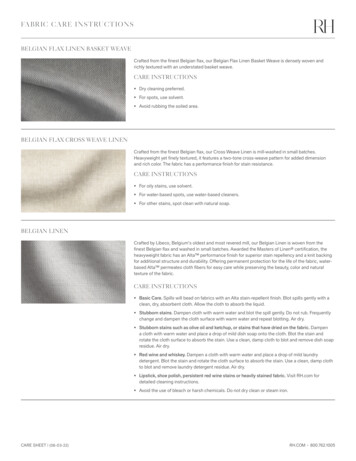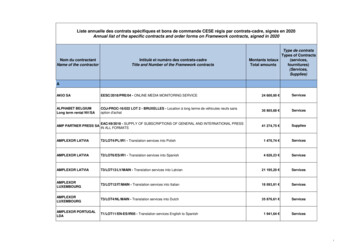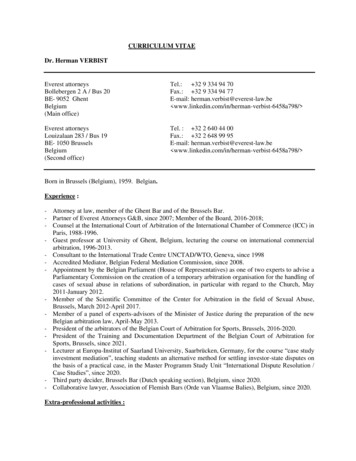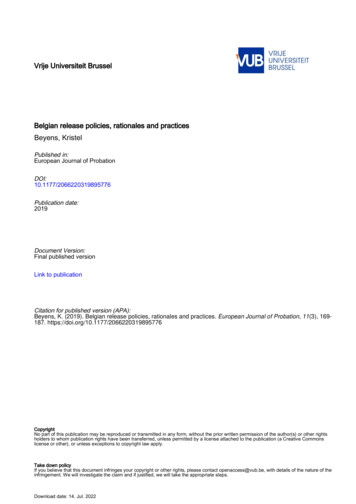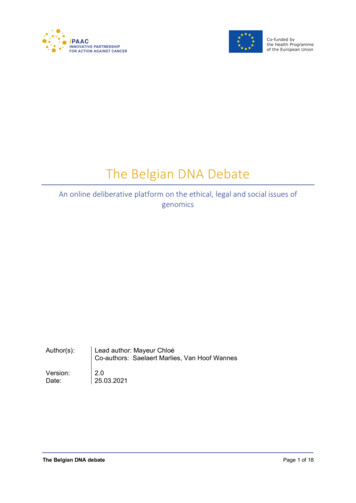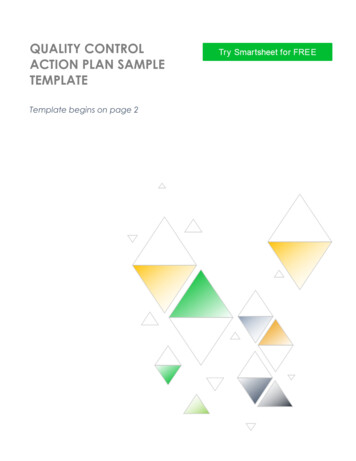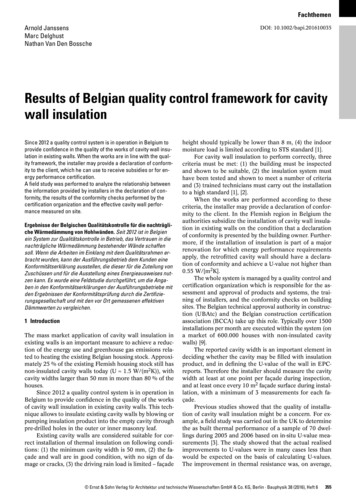
Transcription
FachthemenArnold JanssensMarc DelghustNathan Van Den BosscheDOI: 10.1002/bapi.201610035Results of Belgian quality control framework for cavitywall insulationSince 2012 a quality control system is in operation in Belgium toprovide confidence in the quality of the works of cavity wall insulation in existing walls. When the works are in line with the quality framework, the installer may provide a declaration of conformity to the client, which he can use to receive subsidies or for energy performance certification.A field study was performed to analyze the relationship betweenthe information provided by installers in the declaration of conformity, the results of the conformity checks performed by thecertification organization and the effective cavity wall performance measured on site.Ergebnisse der Belgischen Qualitätskontrolle für die nachträgliche Wärmedämmung von Hohlwänden. Seit 2012 ist in Belgienein System zur Qualitätskontrolle in Betrieb, das Vertrauen in dienachträgliche Wärmedämmung bestehender Wände schaffensoll. Wenn die Arbeiten im Einklang mit dem Qualitätsrahmen erbracht wurden, kann der Ausführungsbetrieb dem Kunden eineKonformitätserklärung ausstellen, die dieser für die Zuteilung vonZuschüssen und für die Ausstellung eines Energieausweises nutzen kann. Es wurde eine Feldstudie durchgeführt, um die Angaben in den Konformitätserklärungen der Ausführungsbetriebe mitden Ergebnissen der Konformitätsprüfung durch die Zertifizierungsgesellschaft und mit den vor Ort gemessenen effektivenDämmwerten zu vergleichen.1 IntroductionThe mass market application of cavity wall insulation inexisting walls is an important measure to achieve a reduction of the energy use and greenhouse gas emissions related to heating the existing Belgian housing stock. Approximately 25 % of the existing Flemish housing stock still hasnon-insulated cavity walls today (U 1.5 W/(m2K)), withcavity widths larger than 50 mm in more than 80 % of thehouses.Since 2012 a quality control system is in operation inBelgium to provide confidence in the quality of the worksof cavity wall insulation in existing cavity walls. This technique allows to insulate existing cavity walls by blowing orpumping insulation product into the empty cavity throughpre-drilled holes in the outer or inner masonry leaf.Existing cavity walls are considered suitable for correct installation of thermal insulation on following conditions: (1) the minimum cavity width is 50 mm, (2) the façade and wall are in good condition, with no sign of damage or cracks, (3) the driving rain load is limited – façadeheight should typically be lower than 8 m, (4) the indoormoisture load is limited according to STS standard [1].For cavity wall insulation to perform correctly, threecriteria must be met: (1) the building must be inspectedand shown to be suitable, (2) the insulation system musthave been tested and shown to meet a number of criteriaand (3) trained technicians must carry out the installationto a high standard [1], [2].When the works are performed according to thesecriteria, the installer may provide a declaration of conformity to the client. In the Flemish region in Belgium theauthorities subsidize the installation of cavity wall insulation in existing walls on the condition that a declarationof conformity is presented by the building owner. Furthermore, if the installation of insulation is part of a majorrenovation for which energy performance requirementsapply, the retrofitted cavity wall should have a declaration of conformity and achieve a U-value not higher than0.55 W/[m2K].The whole system is managed by a quality control andcertification organization which is responsible for the assessment and approval of products and systems, the training of installers, and the conformity checks on buildingsites. The Belgian technical approval authority in construction (UBAtc) and the Belgian construction certificationassociation (BCCA) take up this role. Typically over 1500installations per month are executed within the system (ona market of 600.000 houses with non-insulated cavitywalls) [9].The reported cavity width is an important element indeciding whether the cavity may be filled with insulationproduct, and in defining the U-value of the wall in EPCreports. Therefore the installer should measure the cavitywidth at least at one point per façade during inspection,and at least once every 10 m2 façade surface during installation, with a minimum of 3 measurements for each façade.Previous studies showed that the quality of installation of cavity wall insulation might be a concern. For example, a field study was carried out in the UK to determinethe as built thermal performance of a sample of 70 dwellings during 2005 and 2006 based on in-situ U-value measurements [3]. The study showed that the actual realisedimprovements to U-values were in many cases less thanwould be expected on the basis of calculating U-values.The improvement in thermal resistance was, on average, Ernst & Sohn Verlag für Architektur und technische Wissenschaften GmbH & Co. KG, Berlin · Bauphysik 38 (2016), Heft 6355
A. Janssens/M. Delghust/N. Van Den Bossche · Results of Belgian quality control framework for cavity wall insulation38 % less than that which would be expected on the basisof measured cavity widths.Since the quality control system in Belgium has beenoperational for a relatively small time span, and the conformity checks are performed on a small sample of all installations, it is unclear whether the system effectively meetsthe objectives of improving the quality of the works. Therefore a field study was performed to analyze the relationship between the information provided by the installers inthe declaration of conformity, the results of the conformitychecks performed by the certification organization and theeffective cavity wall performance on site.The analysis of the field study is focusing on both thecompliance of input data and the quality of the works byconfronting the different sources of information:–– Compliance of input data: to what extent is the information provided by installers conforming with specifications (wall area, cavity width, ).–– Quality of the works: relation between measured U-values and theoretical U-value based on reported cavitywidth and insulation product data.2 MethodsThe study is based on the field investigation of 26 detached and semi-detached houses, built between 1900 and1995, with retrofit cavity wall insulation installed in 2012or 2013 under the quality control framework. The fieldmeasurements were performed in winter 2014. The projects were selected in collaboration with BCCA, the organization responsible for the independent audits of certified materials and installers. The selected case studies inthe sample were scattered over Flanders, to get repre sentative results. Next to that, the case studies can besplit according to two parameters: type of insulation product and conformity after installation; which is shown inTable 1.Three insulation products are considered, as these arethe only products with technical approval used on the Belgian market: loose-fill glass wool (MW), EPS-beads andPUR-foam (for this application typically of the open cellular type). More than half of the houses in the sample werechecked by the certification organization and have an auditing report available. During an audit on site the assessorchecks whether the technical guidelines for inspection andproduct installation are correctly followed, and takes material samples for further analysis of product properties. Itwas also decided to include a number of projects for whichthe declaration of conformity was not granted due to noncompliance to one of the installation guidelines. Typicalnon-conformities are of a procedural nature, e.g. incorrectregistration of tests of the installation equipment prior toinstallation.The share of assessed and non-compliant projects inthe sample is not representative for the amount of projectswhich are checked in practice or for the amount of projects that are non-compliant. These cases were included inthe sample to be able to investigate whether the occurrence of independent assessments, or the occurrence ofnon-conformities had an influence on the performance ofthe insulated cavity walls.356Bauphysik 38 (2016), Heft 6Table 1. Number of cases included in each control groupTabelle 1. Anzahl der Fälle in jeder KontrollgruppeCheck BCCACompliant(CC)Check BCCANon-compliant(CNC)Not checkedby BCCA(NC)MW324EPS323PUR324For each case study information was collected fromthe certification organization and the owners, to allow foran accurate estimation of the U-value of the walls, and foran assessment of the correctness of input data provided bythe installers. The following information was used forfurther analysis:–– the declared thermal conductivity of the insulationproduct lD, available in the technical approval document,–– cavity width d, provided in the inspection and installation reports by the installers (in 12 out of 26 projects theinstaller only reported a single value, contrary to specifications),–– results of conformity checks, provided in auditing reports by the independent assessor,–– wall composition, derived from analysis of architecturaldrawings and from observation on site.2.1 U-value calculationFor each project the collected information was used to estimate the wall U-value. The correctness of data provided bythe installers as well as the quality of the works was assessed based on the comparison between the U-value measured on site and the calculated U-values.The design value of a retrofit insulated cavity wall iscalculated according to section 7.2 of STS 71-1 [1]. Thismethod is also included in the specifications for definingtransmission characteristics in the framework of energyperformance regulations [4], which are in force if the installation of insulation is part of a major renovation for whichenergy performance requirements apply (this was not thecase for the projects in this study).The thermal performance of cavity walls is expressedas the corrected heat transfer coefficient Uc (W/m2K), using Eqs. (1), (2).Uc 1 / R T Ucor Uf (1) Ucor 1 / (R T R cor ) 1 / R T (2)total thermal resistance of wall [(m2K)/W]RT Ucor correction factor that takes into account a re duction Rcor of the total thermal resistanceRcor 0.2 (m2K)/W, and takes into account theuncertainties due to imperfections of the installation [W/(m2K)];correction factor for mechanical fixings (wall ties) Ufthrough the insulation layer [W/(m2K)]
A. Janssens/M. Delghust/N. Van Den Bossche · Results of Belgian quality control framework for cavity wall insulationIf no declared thermal conductivity is available for one ofthe material layers, default values are given in Appendix Aof the specifications [4] These values were used for all thematerial layers, except for the insulation layer. The thermalresistance of the insulation layer was calculated using thedeclared thermal conductivity provided by the manufacturer.Several sources of uncertainty exist in the definitionof the U-value of an insulated existing cavity wall: cavitywidth, wall composition and thermal properties of materiallayers, imperfections of installation The uncertainty interval is estimated based on the value Rcor of 0.2 (m2K)/W.A calculation example is given in Table 2.2.2 Field measurementsFor each case-study, a heat flow meter measurement wasmade during winter 2014, measuring the heat-flux on theinside wall surface and the surface-temperature on bothsides of the wall. The measuring equipment was installedat two adjacent locations. Positioning of the sensors wasoptimized based on thermography to make sure that themeasurements were not disturbed by local thermalbridging [5]. Each measurement period lasted at least 5days up to 12 days, with measurement intervals smallerthan 1 minute for the sensors on the inside surface andsmaller than 5 minutes for the temperature sensor on theoutside.The measurement data was analysed with both theaverage methods and the dynamic method in accordanceto ISO 9869 [6], [8]. The average method is based on thesimple relationship between steady-state heat-flux, temperature difference across the wall and thermal resistanceof the wall. Eq.(3) gives the estimate of the average methodof the surface to surface heat resistance after N measurements. The U-value is estimated by adding the theoreticalvalues of surface resistances Rsi and Rse to the estimatedsurface to surface resistance and inverting this sum, withRsi 0.13 m2K/W and Rse 0.04 m2K/W.N (Ti,s,k To,s,k)R N,s to s k 1 N (3) qi,s,kk ce thermal resistance [m2K/W]time series of individual measurementinside surface temperature [K]outside surface temperature [K]inside surface heat flux [W/m2].Because of the dynamic boundary conditions in-situ, themeasured values are averaged over a large amount oftime, of at least 3 days. Taking into account the prominent daily cycles of the boundary conditions, the end-result is calculated after a round number of 24 hours. Anumber of conditions have to be met in order to obtainreliable results, eg the estimate at the end of the test period should not deviate by more than 5 % from the estimate at 24 hours before. For most of the cases, the neces-Table 2. U-value calculation for case 1.1 - MWTabelle 2. U-Wert-Berechnung für Fall 1.1 – Glaswolled [m]λ [W/mK]R [m2K/W]U –Brick0.091.610.056–Rse––0.04– 03Uc–––0.42[0.38–0.45]sary convergence criteria were only met after at least 5days.This summation over time might not always be enoughto compensate for the variations in inside and outside temperature, depending on the thermal capacity of the wall.Therefore, “storage correction” factors are proposed in thenorm, based on estimations of the thermal properties ofthe wall. In the framework of this research, the averagemethod was always applied both with and without storagecorrection factors, even when it was not necessary according to the norm.The other method described in the norm, the dynamicanalysis method, was also applied on all measurements.This approach is built on a set of linear equations to besolved in order to find the time-based relationship betweenthe temperature variations on both sides of the wall andthe measured heat flux. The accuracy of the defined variables is tested by comparing the measured values of theheat-flux over time to an estimate, calculated with thesevariables. With this more complex method, the thermaltransmittance of the wall can often be determined after asmaller measurement period. For each set of data, the dynamic analysis was applied repeatedly with 1 to 8 timeconstants, selecting afterwards the result with the smallestconfidence interval. Further individual analysis of eachmeasurement, mainly through visual analysis of the chartsappeared to be crucial for reaching the best results.The application of the different data analysis methodsresults in three different U-values. Also the measuring uncertainty depends on the analysis method chosen. Themeasuring uncertainty was estimated for each individualmeasurement and method according to the norm, takinginto account uncertainties related to measuring accuracy,installation and operational errors, and to the data analysismethod and the way it copes with signal variations. To estimate total uncertainty the quadrature sum of contributing errors was taken.As an example, Table 3 shows all resulting estimatesfor case 1.1. The example illustrates how the storage correction factors help to obtain reliable results with the average method: for sensor 1 the convergence criteria were notmet when no storage correction was applied. For this ex-Bauphysik 38 (2016), Heft 6357
A. Janssens/M. Delghust/N. Van Den Bossche · Results of Belgian quality control framework for cavity wall insulationTable 3. U-value estimates for case 1.1 - MW based on heatflow meter measurementsTabelle 3. U-Wert-Schätzungen für Fall 1.1 – Glaswolle,nach Messungen des WärmeflussesSensor 1ISO 9869methodU-value[W/(m2K)]Method 1*)Sensor 2UncertaintyU-valueUncer[W/(m2K)] taintyNo 4412%0.4512%*) Method1 average method without storage correction; Method2 average method with storage correction; Method 3 dynamicmethod.ample the results of the average method with storage correction are consistent with the results of the dynamic analysis method: the values of one method fall within the confidence intervals of the other method. Compared to thetheoretical value for this wall, presented in Table 2, themeasured values show good agreement, except for the estimate obtained for sensor 2 using the average method,which falls outside the theoretical confidence interval of0.38-0.45 W/(m2K).However, contrary to the example, not in all cases theresults of the different analysis methods were consistent.In a large number of measurements the estimates based onthe dynamic analysis method showed large uncertainties( 20 %), with sometimes physically unrealistic values. Forthis reason it was decided to use only the estimated Uvalues based on the average method with storage correction, and to reject the results in cases where the convergence criteria for this method were not met. Finally thisresulted in reliable U-value estimates for 21 out of 26 cases,with maximum uncertainty of 10 %. In the cases with reliable U-value estimates, the mean value of the two sensorswas used as the final result. In cases where a reliable estimate was only obtained with one of the sensors, this singlevalue was used as the final result (4 cases).Of course the heat flow measurements are local measurements and give an estimate of the thermal performanceof the wall at a single position. To complement these measurements and provide information on the continuity andhomogeneity of thermal insulation all case studies weresubjected to thermographic investigations [5], [8]. Theseinvestigations showed a good continuity of the insulationproduct in all case studies, except in 3 EPS-projects whereindications of local gaps or inhomogeneity of the insulation layer were observed.3 ResultsThe quality of the works as well as the correctness of dataprovided by the installers is assessed based on the comparison between the U-value measured on site and the calculated Uc-values. Figure 1 shows the relationship betweenboth sets of U-values. Each symbol represents a case study,with indication of insulation products. The dashed linesrepresent the confidence interval taking into account themeasuring uncertainty and uncertainties in calculation. Asdescribed in the previous sections the uncertainty in calcu-358Bauphysik 38 (2016), Heft 6Fig. 1. Comparison between measured and calculatedU‑values in the case-studies (dashed lines represent the confidence interval taking into account 10 % measuring uncertainty and an uncertainty Rcor 0.2 m2K/W in the calculated U-value)Bild 1. Vergleich gemessener und berechneter U-Werte inden Fallstudien (gestrichelte Linien zeigen das Konfidenzintervall unter Berücksichtigung von 10 % Messunsicherheitsowie Unsicherheit Rcor 0,2 m2K/W beim berechnetenU‑Wert)lation is estimated based on the value Rcor 0.2 m2K/W,and the maximum measuring uncertainty is 10 %. In 33 %of the cases the measured U-value is higher than the calculated value (poorer thermal performance in reality), whilethe opposite is true in 67 % of the cases (better thermalperformance in reality).However, when the confidence interval is taken intoaccount, in none of the cases the measured U-value is significantly higher than the theoretical value. This meansthat the thermal performance of cavity wall insulationmeets the expectations in all of the studied houses. Thelack of continuity or homogeneity in insulation fill observed in thermography’s of three EPS-projects does notlead to poor measured U-values. In 5 out of 21 cases thereis a significant deviation between measured and calculatedvalues, but here the walls seem to perform better than expected. Possible reason is that the reported mean cavitywidth is incorrect or small compared to the local cavitywidth where the measurements were taken. Another possible reason is that the wall composition used for calculation is incorrect. In 2 of these cases there was a gypsumboard internal lining, perhaps hiding a layer not taken intoaccount in the calculation.To analyse differences between the control groups inthe field study, the measured U-values are further analysedin relation to the insulation product and to the results ofconformity checks. In this analysis the 2 cases with gypsumboard internal lining are not considered since the previousanalysis indicated the wall composition may differ fromthat of a typical cavity wall.
A. Janssens/M. Delghust/N. Van Den Bossche · Results of Belgian quality control framework for cavity wall insulationFig. 2. U-value [W/(m2K)] as a function of insulation product and cavity width [m]: mean measured values (bars) versus mean theoretical values Uc (line)Bild 2. U-Wert [W/(m2K)] als Funktion des Dämmmaterialsund der Hohlraumbreite [m]: gemessene Mittelwerte (Balken) im Vergleich zu theoretischen Mittelwerten Uc (Linie)Fig. 3. Mean measured U-value [W/(m2K)] as a function ofresults of conformity checks: checked and compliant (CC),checked and not compliant (CNC), not checked (NC)Bild 3. Mittlerer gemessener U-Wert [W/(m2K)] in Abhängigkeit von Ergebnissen der Konformitätsprüfungen: alskonform geprüft (CC), als nicht konform geprüft (CNC),nicht geprüft (NC)Figure 2 shows the measured U-values as a function ofcavity width and insulation product. The projects are subdivided in 3 groups according to the reported cavity width:–– 50 mm d 55 mm–– 55 mm d 65 mm–– 65 mm d 70 mmcorrect cavity width and simply report the minimum widthof 50 mm, which is the necessary condition in the qualitycontrol framework for a cavity wall to be suitable for installing insulation. There is certainly no indication thatcavity walls with cavity widths smaller than 50 mm andtherefore not suitable for insulation were wrongly assessedby installers to be suitable.Figure 3 shows the mean measured U-values as a function of the results of conformity checks by independentassessors. For each control group (CC, CNC, NC) themean and standard deviation of the measured U-valueswas taken. There is no significant difference between themeasured U-values in the control groups. This means thatthe correct installation of insulation product is maintainedalso in projects without conformity check, or in projectswith non-conformities. Since the established performancedoes not seem to depend on the occurrence of conformitychecks, this is an indication that the full quality chain, suchas implemented in Belgium, leads to reliable results. Although conformity checks by independent assessors areperformed on a small sample of all installations, this seemsto be sufficient to guarantee the effectiveness of the qualitycontrol framework for thermal performance.Although in none of the case studies the installationof insulation was part of a major renovation for which energy performance requirements applied, it is interesting tocompare the U-values to the requirement that would be inforce in that case: retrofitted cavity walls should achieve atheoretical Uc-value not higher than 0.55 W/(m2K). In 16out of 26 cases (62 %) the theoretical Uc-value meets thisrequirement, while in 14 out of 21 cases (67 %) the mea-The bars in Fig. 2 represent the mean measured values ineach group, with the error bars indicating the standarddeviation. When no error bar is drawn, there is only a single measured value in the group. These measured valuesare compared to the mean theoretical value Uc in eachgroup, represented by the line in the graph. The mean measured values vary between 0.40 and 0.55 W/(m2K), with nosignificant differences between the three groups of insulation products. Compared to typical U-values of not insulated existing cavity walls [7] the thermal performance ofthese walls has improved by a factor 3.The comparison between mean measured and theoretical values in Fig. 2 shows that there is a good correspondence between both in projects with cavity widthslarger than 55 mm. In the group with the narrowest cavities (in between 50 and 55 mm) the mean measured valuesare substantially lower than the theoretical by 16 % (EPS),21 % (PUR) and 38 % (MW). In fact there is no significantdifference between the mean measured values in the groupwith cavity widths smaller than 55 mm, and the one withcavity widths in between 55 and 65 mm.Although two of the outliers discussed before are alsoincluded in the first group, this is not sufficient to explainthe deviation. Perhaps some installers fail to report theBauphysik 38 (2016), Heft 6359
A. Janssens/M. Delghust/N. Van Den Bossche · Results of Belgian quality control framework for cavity wall insulationsured U-value meets the requirement. The 10 cases that arenon-compliant (Uc) are cases with narrow cavities (8 caseswith cavity width 55 mm, 2 cases with cavity width inbetween 55 and 60 mm). In renovation projects for whichenergy performance requirements apply, the minimum cavity width should thus typically be larger than the minimumsuitability requirement of 50 mm in order to comply toenergy performance regulations. The development of insulation products with improved thermal properties couldhelp to meet energy performance requirements even in existing cavity walls with narrow cavities.Although in none of the case studies the installationof insulation was part of a major renovation for whichenergy performance requirements applied, the U-valuesachieved in the case studies were compared to the requirement that would be in force in that case. The comparisonshowed that it is difficult to meet the requirement in cavitywalls with a cavity width smaller than 60 mm. The development of insulation products with improved thermalproperties compared to the approved existing productscould help to meet energy performance requirements inexisting cavity walls with narrow cavities.4 ConclusionAcknowledgementThe study is based on the field investigation of 26 detachedand semi-detached houses, with retrofit cavity wall insulation installed in 2012 or 2013 under the quality controlframework. The analysis of the field study is focusing onboth the compliance of input data and the quality of theworks by confronting the different sources of information:–– Compliance of input data: to what extent is the information provided by installers conforming with specifications (wall area, cavity width, ).–– Quality of the works: relation between measured U-values estimated from heat flow meter measurements, andtheoretical U-values based on reported cavity width andinsulation product data.This study was performed in the context of the IEE project QualiChEck (http://qualicheck-platform.eu/). Thesupport is gratefully acknowledged.The study showed that the cavity width of the insulatedcavity wall was often not reported correctly by installersand was therefore often not compliant to specifications. In12 out of 26 cases (46 %) the cavity width was reported asa single value, while multiple measurements should be taken and reported. However, based on the comparison between measured and calculated U-values, there was no evidence that the reported values were wrong. There is alsono indication that cavity walls with cavity widths smallerthan 50 mm and therefore not suitable for insulation werewrongly assessed by installers to be suitable.The study further showed the effectiveness of the quality control framework. The measured U-values vary between 0.31 and 0.66 W/(m2K), with no significant differences between the three groups of insulation products studied. In 3 out of 26 cases (12 %) a thermographicinvestigation revealed a minor lack of continuity or homogeneity of the insulation product, but this did not result inpoor measured U-values. In none of the cases the measured U-value was significantly higher than the theoreticalvalue. This means that the thermal performance of cavitywall insulation meets the expectations in all of the studiedhouses. The measurements further showed that the correctinstallation of insulation product was maintained also inprojects without conformity check, or in projects with nonconformities. Since the established performance did notseem to depend on the occurrence of conformity checks,this is an indication that the full quality chain, such asimplemented in Belgium, leads to reliable results and goodquality of the works.360Bauphysik 38 (2016), Heft 6References[1] STS 71-1 Na-isolatie van spouwmuren door in-situ vullenvan de luchtspouw met een nominale breedte van ten minste50 mm (in Dutch). Federale overheidsdienst economie, Algemene directie kwaliteit en veiligheid. 2012.[2] Janssens A., Wagneur, M., Wijnants, J., Winnepenninckx, E.:Na-isolatie van spouwmuren door het opvullen van de luchtspouw (in Dutch). Technische voorlichting 246. Wetenschappelijk en Technisch Centrum voor het Bouwbedrijf. 2012.[3] Doran, S., Carr, B.: Thermal transmittance of walls of dwellings before and after application of insulation. BRE report nr.222077. 2008.[4] Transmissiereferentiedocument (TRD), Belgisch staatsblad,2010 & 2014 (extension).[5] NBN EN 13187:1999. Thermal performance of buildings.Qualitative detection of thermal irregularities in building envelopes. Infrared method.[6] ISO 9869:2014 (E) Thermal insulation – Building elements– In-situ measurement of thermal resistance and thermaltransmittance. Part 1: Heat Flow Meter Method.[7] Delghust, M., Janssens, A., Rummens, J.: Retrofit cavity wallinsulation: performance analysis from in-situ measurements.CESBP 2010. Proceedings of the 1st Central Euro
The whole system is managed by a quality control and certification organization which is responsible for the as-sessment and approval of products and systems, the trai-ning of installers, and the conformity checks on building sites. The Belgian technical approval authority in construc-tion (UBAtc) and the Belgian construction certification
